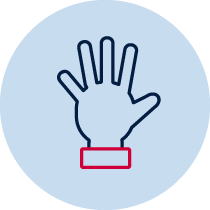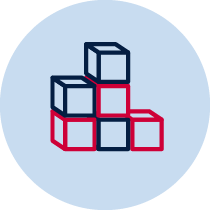2D space – Guess my shape
Gauge students' understanding of 2D shape concepts and position concepts.
 |
 |
 |
 |
 |
 |
| Practical | Build or make | Resource required | Verbal recording | Take photo | Collaborative |
Mathematics Stage 1 diagnostic tasks can be used by teachers to generate a snapshot of student learning aligned to syllabus expectations at Stage 1. This information may assist teachers in tailoring teaching and learning experiences to more effectively meet students’ needs.
Measurement and geometry – 2D space and position
- describes mathematical situations and methods using everyday and some mathematical language, actions, materials, diagrams and symbols MA1-1WM
- uses objects, diagrams and technology to explore mathematical problems MA1-2WM
- supports conclusions by explaining or demonstrating how answers were obtained MA1-3WM
- manipulates, sorts, represents, describes and explores two-dimensional shapes, including quadrilaterals, pentagons, hexagons and octagons MA1-15MG
- represents and describes the positions of objects in everyday situations and on maps MA1-16MG
Content
2D space 1
Recognise and classify familiar two-dimensional shapes using obvious features (ACMMG022)
- describe features of two-dimensional shapes using the terms ‘side’ and ‘vertex’ (communicating)
- recognise that the name of a shape does not change when the shape changes its orientation in space, eg a square turned on its vertex is still a square (communicating, reasoning)
- select a shape from a description of its features (reasoning)
2D space 2
Investigate the effect of one-step slides and flips, with and without the use of digital technologies (ACMMG045)
Identify and describe half-turns and quarter-turns (ACMMG046)
- recognise that turning a shape does not change its size or features (reasoning)
- describe the result of a turn of a shape, for example, ‘When the shape does a half-turn, it is the same but upside-down' (communicating)
Position 2
Describe the positions of objects in models, photographs and drawings
- give reasons when answering questions about the positions of objects (communicating, reasoning)
- make simple model from memory, photographs, drawings or descriptions, for example students make a model of their classroom
- use knowledge of positions in real-world contexts to re-create models (communicating)
National Numeracy Learning Progression Mapping to the NSW mathematics syllabus
When working towards the outcome MA1-15MG the sub-elements (and levels) of Interpreting fractions (InF1) and understanding geometric properties (UGP2-UPG4) describe observable behaviours that can aid teachers in making evidence-based decisions about student development and future learning.
When working towards the outcome MA1-16MG the sub-elements (and levels) of Positioning and locating (PoL2-PoL3) describe observable behaviours that can aid teachers in making evidence-based decisions about student development and future learning.
Materials
- Paper and pencils
- video recording device (optional)
- geometric pattern blocks
Teacher instructions
The purpose of this task is to gauge students' understanding of 2D shape concepts such as:
- recognise familiar two-dimensional shapes using obvious features
- classify familiar two-dimensional shapes using obvious features
- describe features of two-dimensional shapes using the terms ‘side’ and ‘vertex’
- recognise that the name of a shape does not change when the shape changes its orientation in space
- select a shape from a description of its features
- investigate the effect of one-step slides and flips
- Identify and describe half-turns and quarter-turns
- recognise that turning a shape does not change its size or features
- describe the result of a turn of a shape
The purpose of this task is to gauge students' understanding of position concepts such as:
- describe the positions of objects in models
- give reasons when answering questions about the positions of objects
- make simple model from descriptions
- use knowledge of positions in real-world contexts to re-create models
Using geometric shape blocks, students are tasked with creating a design with approximately 3-5 blocks. In groups, students then describe their design and write (or verbally explain) instructions, so another group of students can remake it. Students refine their instructions based on feedback provided by their peers and self-reflection. The instructions can be written and/or photographed/video-recorded/audio-recorded. The feedback process can be repeated several times, so that students have ample opportunities to refine, improve and trial the effectiveness of their instructions.
Prompting questions
Comparing the design you came up with based on the instructions and the photograph of what it is supposed to look like, how do you think this group can improve their instructions? What step/s needs refining?
Students should be able to communicate using the following language: shape, circle, triangle, quadrilateral, square, rectangle, pentagon, hexagon, octagon, features, side, vertex (vertices), vertical, horizontal, parallel, two-dimensional shape (2D shape), slide, flip, turn, full-turn, half-turn, quarter-turn, clockwise, anti-clockwise, left, right.
Student instructions
Make a design using these geometric blocks. You only need to use a few.
Can you record (written and/or photograph/video/audio-record) a set of instructions, so another group can make your design without seeing it?
Consider the mathematical language in your instructions. Trial the instructions and then refine them in response to their effectiveness and feedback from your peers.
Possible areas for further exploration
- mathematical language
- recognising and classifying two-dimensional shapes
- collaborative group work skills
- quality feedback
Where to next?
- using symmetrical patterns
- using a larger number of blocks to create a more detailed design
Syllabus
Please note:
Syllabus outcomes and content descriptors from Mathematics K-10 Syllabus © NSW Education Standards Authority (NESA) for and on behalf of the Crown in right of the State of New South Wales, 2012